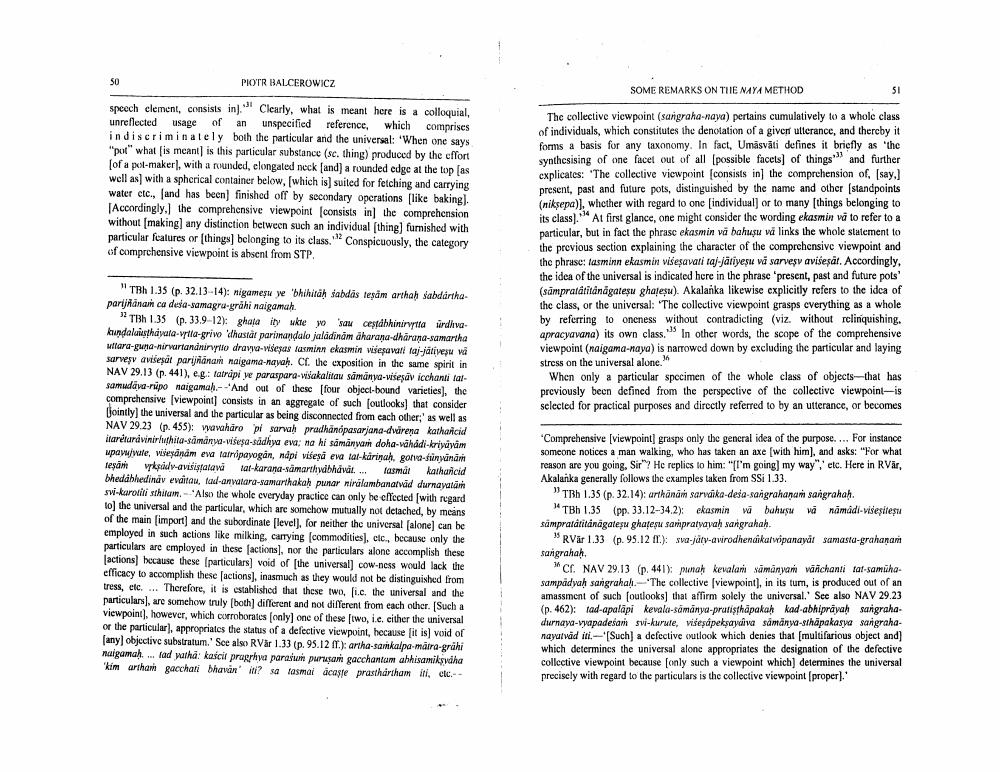Book Title: Some Remarks On The Naya Mmethod Author(s): Piotr Balcerowicz Publisher: Piotr Balcerowicz View full book textPage 8
________________ PIOTR BALCEROWICZ SOME REMARKS ON THE NAYA METHOD speech element, consists in). Clearly, what is meant here is a colloquial, unreflected usage of an unspecified reference, which comprises indiscriminalely both the particular and the universal: 'When one says "pot" what is meant is this particular substance (sc. thing) produced by the effort (of a pl-maker, with a rounded, elongated neck (and) a rounded edge at the top (as well as with a spherical container below, (which is) suited for fetching and carrying water etc., and has been finished off by secondary operations (like baking). Accordingly, the comprehensive viewpoint consists in the comprehension without making any distinction between such an individual thing] furnished with particular features or things belonging to its class. Conspicuously, the category of comprehensive viewpoint is absent from STP. The collective viewpoint (sangrahe-naya) pertains cumulatively to a whole class of individuals, which constitutes the denotation of a giver utterance, and thereby it fomis a basis for any taxonomy. In fact, Umásváti defines it briefly as the synthesising of one facet out of all possible facets of things and further explicates: 'The collective viewpoint [consists in the comprehension of say.] present, past and future pots, distinguished by the name and other standpoints (niksepa)], whether with regard to one (individual) or to many things belonging to its class). At first glance, one might consider the wording ekasmin và to refer to a particular, but in fact the phraseekasmin vā bahuşu và links the whole statement to the previous section explaining the character of the comprehensive viewpoint and the phrase: lasminnekasmin višesavati taj-jatiyesi vi sarves avisesår. Accordingly, the idea of the universal is indicated here in the phrase 'present, past and future pots' (sampratátitánågatesu ghalesu). Akalanka likewise explicitly refers to the idea of the class, or the universal: "The collective viewpoint grasps everything as a whole by referring to oneness without contradicting (viz. without relinquishing. apracyavana) its own class. In other words, the scope of the comprehensive viewpoint (naigama-naya) is narrowed down by excluding the particular and laying stress on the universal alone When only a particular specimen of the whole class of objects that has previously been defined from the perspective of the collective viewpointis selected for practical purposes and directly referred to by an utterance, or becomes "Th 1.35 (p. 32.13-14): nigameşu we Whihirah sabdás team arthah sabdartha parijana ca desa-samagru.gråhi naigamah. Tih 135 (p. 33.9-12): ghata i we yo 'sa cehhinirytta urdha kundaluisthyuta-via-grive hasta parimandalo jaldind dharana dharuna-samartha uffara-guna.nirvartananirypto dravy-visepas lasminnekasmin Vijesavati faj-jätveju vi Sarvesvaviseat parijina naigama-nayah. Ct. the exposition in the same spirit in NAV 29.13 (p. 441), eg: tatrapi ve paraspara-wakalitou sámánya-wisesav icchanti talsamudava-rupo nagamah-And out of these [four object-bound varieties), the comprehensive [viewpoint) consists in an aggregate of such (outlooks that consider ljointly, the universal and the particular as being disconnected from cach other' as well as NAV 29.23 (p. 455): Wawaharop sarah pradhan pasarjana-duarena kathariid ilaretarávinirishita-samanya višeya-sadhya eva; na hi samanyan doha-vähádi-krivim wpaw/wale, weydnám eva fairvipavogan, ndi visega ewa tal-kárina gora-finna lesanii wkwavisistatawi lar karana-samarthyddol... fasmál kathariid bheddhhedináv evaitau, tud-an watara-samarthakah punar niralambanatvad durnaald svi-karotili sthitum. Also the whole everyday practice can only be elected with regard to the universal and the particular, which are somehow mutually not detached, by means of the main (import and the subordinate [level), for neither the universal (alone can be employed in such actions like milking, carrying commodities), oto, because only the particulars are employed in these factions), nor the particulars alone accomplish these Jactions because these particulars) void of the universal] cow.ness would lack the efficacy to accomplish these factions], inasmuch as they would not be distinguished from tress, etc... Therefore, it is established that these two, fi.c. the universal and the particulars), are somehow truly (both) different and not different from each other. (Such a viewpoint), however, which roborates (only one of these two, le, either the universal or the particular), appropriates the status of a defective viewpoint, hecause it is) void of (any) objective substratum.' See also RVär 1.33 (p. 95.12 IT.): artha-sankalpa mätra-grái maigumah.... tad atha: kasci praghya para purusa gacchantum ahhisamiksha "kim artham gacchati bhavan' it? sa tasmal acaste prastharshamiti, ctc. Comprehensive [viewpoint) grasps only the general idea of the purpose.... For instance someone notices a man walking, who has taken an axe with him), and asks: "For what reason are you going. Sir"? He replies to him: "I'm going) my way", etc. Here in RVär, Akalanka generally follows the examples taken from SSi 1.33. Tih 1.35 (p. 32.14): arthana sandika-des-sangrahanam sangrahah. "TBh 35 ( 3312-342) CẤarriển wã đa sự và nămiải Viettiesta sampralátitándgatesu ghafesu sampratyayah sangrahah. RVär 1.33 (p. 95.12 1.): svadrv-awirodhendika wipanayil samasta grahanam sangrahah. C. NAV 29.13 (p. 441): punah kevalaisimnyai varchanli taf-samaha collective viewpoint), in its tum, is produced out of an amassment of such foutlooks) that affirm solely the universal.' See also NAV 29.23 (p. 462): tad-apalapi kevala-sámánya-prutishapakah kad-abhiprayah sangraha durnava-vapadesanisi-kurute, widesapeksayda samanwa sthapakasya sangraha nayulvaditi.- Such) a defective cutlook which denies that (multifarious object and] which determines the universal alone appropriates the designation of the defective collective viewpoint because only such a viewpoint which) determines the universal precisely with regard to the particulars is the collective viewpoint (proper).Page Navigation
1 ... 6 7 8 9 10 11 12 13 14 15 16 17
